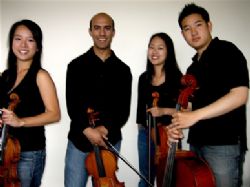|
Choral and Vocal
CANTIAMO SONOMA'S LUSCIOUS A CAPELLA SINGING IN SEASON ENDING CONCERT
by Pamela Hicks Gailey
Sunday, June 8, 2025
Symphony
SRS SEASON ENDS WITH RESOUNDING TA-TA-TA-BANG
by Terry McNeill
Sunday, June 1, 2025
Symphony
YOUTHFUL VIRTUOSITY ON DISPLAY AT USO'S MAY CONCERTS
by Peter Lert
Saturday, May 17, 2025
Symphony
MYSTICAL PLANETS AND LIVELY GERSHWIN ORTIZ AT FINAL SRS CONCERT
by Peter Lert
Sunday, May 4, 2025
Symphony
VSO'S CONCERT MUSIC OF TIME, MUSIC OF PLACE
by Peter Lert
Sunday, April 27, 2025
VOCAL ELEGANCE AND FIRE AT THE 222'S RECITAL APRIL 26
by Pamela Hicks Gailey
Saturday, April 26, 2025
CANTIAMO SONOMA SINGS AN INSPIRED GOOD FRIDAY MOZART REQUIEM CONCERT
by Pamela Hicks Gailey
Friday, April 18, 2025
DRAMATIC SHOSTAKOVICH SYMPHONY CLOSES PHILHARMONIC'S 25TH SEASON
by Terry McNeill
Sunday, April 13, 2025
LARGE COLLEGE OF MARIN AUDIENCE GREETS STOPHER ARTISTRY
by Terry McNeill
Saturday, April 5, 2025
Chamber
FRISSON DELIVERS SHIVERS OF DELIGHT
by Abby Wasserman
Sunday, March 30, 2025
|
 |
 The Afiara String Quartet |
TWO STEPS FORWARD, ONE STEP BACK
by Steve Osborn
Saturday, January 17, 2009
Every string quartet has to start somewhere. For the Afiara String Quartet, that somewhere includes the Occidental Community Church, where they performed on Jan. 17.
The Afiara is quite young and relatively new, having formed at the San Francisco Conservatory in 2006. Blessed with impeccable academic credentials, they are currently teaching assistants to the Alexander String Quartet at San Francisco State University.
Whether the Afiaraís credentials translate into solid music-making is an open question, and remained so after their Occidental performance. While they showed flashes of brilliance in Bartokís String Quartet No. 3, their musical light flickered somewhat in Mozartís K. 428, and dimmed considerably in Beethovenís Op. 130.
Letís start at the beginning. Warmly welcomed by another full house crammed into the churchís knee-capping pews, the Afiara got right down to business with an engaging reading of Mozartís K. 428, the third of the six string quartets he dedicated to Joseph Haydn. They displayed an excellent blend in the Allegro first movement, with well-connected notes and a wide dynamic range. The pleasing blend continued into the luxurious Andante of the second movement, enhanced by matching vibratos and a lush sound.
The third movement, alas, began with a timid attack, weakened all the more by a dragging tempo. What should have been a Minuet became more of a foot stomp, and the previously distinctive texture turned to mush. Fortunately, the players rallied in the last movement, investing Mozartís operatic writing with some genuine emotion.
Next up was Bartok No. 3. Oddly, the violist gave a somewhat condescending introduction to the piece, along the lines of, ďItís filled with unusual sounds, but itís only 15 minutes long, so please bear with us.Ē Surely by now, more than 80 years after the quartetís premiere, audiences can enjoy this masterpiece without a preparatory lecture.
The performance, in any event, was absolutely riveting. From the opening glissandos to the ringing unisons, the Afiara produced a beautiful sound that powerfully evoked Bartokís native landscape. One could almost see the Hungarian plains, with their constantly buzzing insects and foreboding skies. At one point, the quartet produced an all-encompassing vault of sound, with the cellist serving as foundation, the middle instruments as sides, and the first violin soaring above. The range of effects, from resonant pizzicatos to spine-tingling ponticellos, increased the density and variety of the sonic mass, which more than filled the little church.
It seemed like a hard performance to top, and it was. After an overly long intermission with yet another introduction, the Afiara launched into the original version of Beethovenís Op. 130, which concludes with the mighty Grosse Fuge. Right from the start, the texture was muddy, and the first violinistís intonation went south. The quartet played the notes, but they didnít seem to have figured out an interpretation. The phrasing was indistinct, the shape elusive.
The connections between the six movements of Op. 130 were further diminished by the quartetís constant tuning and retuning. Instead of the coherent masterpiece it is, the piece ended up sounding like a dance suite. Although the dances were occasionally sprightly, they were most often ponderous and slow. The playing perked up in the Grosse Fuge, particularly in the initial entries, where each instrument forged a distinctive voice. But after a while the ensemble faltered, and the four musicians wandered apart, searching for their musical glue.
At the end, one wished the Afiara hadnít taken on such an ambitious program. There are plenty of compositions that might be better suited to their talents and insight. Late Beethoven is a tough place to start.
|
